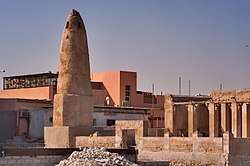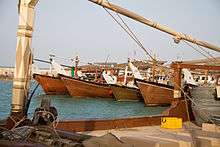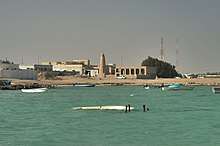Ar Ru'ays
| Ar Ru'ays اَلرُّؤَيْس | |
|---|---|
| Town | |
 | |
 Ar Ru'ays Ar Ru'ays | |
| Coordinates: 26°08′00″N 51°13′00″E / 26.13333°N 51.21667°ECoordinates: 26°08′00″N 51°13′00″E / 26.13333°N 51.21667°E | |
| Country | Qatar |
| Municipality | Al Shamal |

Ar Ru'ays (Arabic: اَلرُّؤَيْس), also spelled Al Ruwais, is a port town in the municipality of Al Shamal in Qatar.[1] It is located on the northern tip of Qatar, approximately 127 km north of the capital Doha.[2]
Etymology
Ar Ru'ays translates to 'small head' in Arabic. It was so named because the town juts out into the sea relative to the land surrounding it.[3]
History
A British survey conducted on the area in 1890 describes Al Ruwais as "a small town on the mainland, 2 ½ miles south of Ras Rakan; it has four towers on the fort, which is the first thing seen from the northward when making the land. They have many boats, which run in over the reef, and anchor in shelter close to the beach. The fort is visible 6 or 7 miles".[4]
At the start of the 20th century, Al Ruwais was described as such in J.G. Lorimer's Gazetteer of the Persian Gulf:
A village of Qatar, the nearest to the top of the promontory, about 2 ½ miles south of Ras Rakan. It is inhabited by about 70 families of the Sadah tribe who own 18 pearl boats, 2 other sea-going vessels and 10 fishing boats; they also have 4 horses and 20 camels. There is a reef in front of the village within which the boats belonging to it anchor. The place is protected by a small fort with four towers, and drinking water is fetched from the Umm Dha'an well, 1 ½ miles inland south of Ruwais.[5]
In an earlier 1904 transcript of Lorimer's Gazeetteer, he remarks that before 1856, roughly 100 inhabitants of the Bu Kuwara and Utub tribes resided in Al Ruwais.[6]
Al Ruwais became the second settlement outside of the capital Doha to construct a formal school in 1954.[7]
Geography

Situated along the northern coastline, Al Ruwais is bordered by the villages of Madinat ash Shamal and Abu Dhalouf to the immediate west. It is roughly 127 km northwest of the capital Doha, 25 km northwest of Fuwayrit, 28 km northeast of Zubarah, and 77 km northwest of Al Khor.[8]
Al Ruwais' coastal area is a popular destination due to its lush vegetation. In recent years, the Ministry of Municipality and Environment have embarked on campaigns to restore the mangroves that grow abundantly on its coast.[9] Roughly 13 hectares of coastal mangroves are found in Al Ruwais.[10]
Climate
The following is climate data for Ar Ru'ays obtained from the Qatar Statistics Authority.
| Climate data for Ar Ru'ays | |||||||||||||
|---|---|---|---|---|---|---|---|---|---|---|---|---|---|
| Month | Jan | Feb | Mar | Apr | May | Jun | Jul | Aug | Sep | Oct | Nov | Dec | Year |
| Average high °C (°F) | 24 (75) |
26 (79) |
31 (88) |
37 (99) |
44 (111) |
47 (117) |
48 (118) |
48 (118) |
43 (109) |
39 (102) |
31 (88) |
26 (79) |
37 (99) |
| Average low °C (°F) | 13 (55) |
14 (57) |
17 (63) |
23 (73) |
27 (81) |
30 (86) |
32 (90) |
32 (90) |
28 (82) |
24 (75) |
18 (64) |
14 (57) |
23 (73) |
| Average precipitation mm (inches) | 13 (0.51) |
2 (0.08) |
2 (0.08) |
5.5 (0.217) |
1 (0.04) |
0 (0) |
0 (0) |
0 (0) |
0 (0) |
0.5 (0.02) |
15 (0.59) |
23 (0.91) |
62 (2.447) |
| Average relative humidity (%) | 77 | 71 | 57 | 52 | 41 | 40 | 43 | 53 | 58 | 61 | 70 | 83 | 59 |
| Source: Qatar Statistics Authority[11] | |||||||||||||
Architecture
One of the earliest harbor towns in Qatar, Al Ruwais accommodates what is believed to be the oldest mosque in Qatar. Initially built around the 17th century, Ruwais Mosque was reconstructed in the 1940s.[12] It is rectangular in shape, with an open courtyard, and can hold around 100 worshipers.[13] The Ministry of Tourism and Al Shamal Municipality are coordinating to preserve the mosque and to promote it as a tourist attraction.[14] From December 2014 to January 2015, archaeologists from the Qatar Museums Authority excavated the eastern portion of the mosque, unearthing pottery shards, animal bones and coins.[15]
Visitor attractions

Al Ruwais is a popular birdwatching spot.[16]
In May 2018, the Al Shamal Corniche was inaugurated in Al Ruwais. It features a 2,570 meters-long promenade, 120 parking spots and 450 trees. Still to be developed facilities include a childrens' play area spanning 2,000 meters.[17]
Infrastructure
A government complex housing a Ministry of Justice office was opened in Al Ruwais in July 2014.[18]
Al Ruwais Port
Al Ruwais Port development project, which has the stated aim of transforming Al Ruwais Port into northern Qatar's pathway to the world, was launched in January 2015 by Prime Minister Abdullah bin Nasser bin Khalifa Al Thani.[19] It was reported that, in June 2017, Al Ruwais Port had 57 ships with an overall capacity reaching 10,745 tons.[20] Mwani Qatar, the authority overseeing the port, established a 77,000 square meters truck parking lot with 285 spaces near Al Ruwais Port. It became fully operational in March 2018.[21]
References
- ↑ "2010 population census" (PDF). Qatar Statistics Authority. Retrieved 2 July 2015.
- ↑ "همزة وصل .. مدينة الرويس" (in Arabic). Al Raya. 28 January 2015. Retrieved 2 July 2017.
- ↑ "GIS Portal". Ministry of Municipality and Environment. Retrieved 10 August 2017.
- ↑ The Persian Gulf pilot: comprising the Persian Gulf, Gulf of Omán; and Makran coast. Great Britain: Hydrographic Dept. 1890. p. 127.
- ↑ "'Gazetteer of Arabia Vol. II' [1599] (678/688)". Qatar Digital Library. Retrieved 28 July 2015. This article incorporates text from this source, which is in the public domain.
- ↑ "'Persian Gulf Gazetteer, Part II: Geographical and descriptive materials, Section II: Western Side of the Gulf' [56v] (112/280)". Qatar Digital Library. Retrieved 21 August 2018.
- ↑ Abdulla Juma Kobaisi (1979). "The Development of Education in Qatar, 1950–1970" (PDF). Durham University. p. 38. Retrieved 19 December 2015.
- ↑ Whelan, John (1983). Qatar, a MEED practical guide. London: Middle East Economic Digest. p. 160. ISBN 0950521191.
- ↑ "MME restores mangroves in Al Ruwais coastal area". The Peninsula. 18 May 2018. Retrieved 25 June 2018.
- ↑ Mohammad Ahmad Shehadi (May 2015). "Vulnerability of mangroves to sea level rise in Qatar: Assessment and identification of vulnerable mangroves areas" (PDF) (Thesis). College of Arts and Sciences - Qatar University. p. 23. Retrieved 25 August 2018.
- ↑ "Temperature/Humidity/Rainfall". Qatar Statistics Authority. Retrieved 24 June 2018.
- ↑ "New life for old Qatar". Qatar Museums. Retrieved 2 July 2017.
- ↑ Nasser Al Hamwi (18 June 2017). "بالصور.. "مسجد الرويس".. عراقة التراث المعماري القطري تستعيد بريقها وألقها" (in Arabic). Al Sharq. Retrieved 2 July 2017.
- ↑ Mohammed Al-Jabali (9 January 2013). "الميناء الجديد ومسجد الرويس وقلعة الزبارة و13 قرية تؤهل الشمال لاحتلال موقع سياحي ريادي" (in Arabic). Al Arab. Retrieved 2 July 2017.
- ↑ "متاحف قطر تنظم خمسة معارض في برنامج الربيع" (in Arabic). Al Raya. 26 February 2015. Retrieved 19 July 2018.
- ↑ "Marhaba's Guide to the Natural World and Nature Reserves in Qatar". Marhaba.qa. Retrieved 2015-07-09.
- ↑ "Opening of Al Shamal Corniche Development Project". Ashghal. 13 May 2018. Retrieved 22 June 2018.
- ↑ "MoJ opens office in Ruwais". Qatar e-Government. 20 July 2014. Retrieved 2 July 2017.
- ↑ "Premier launches Al Ruwais Port development project". Qatar Is Booming. 10 January 2015. Retrieved 2 July 2017.
- ↑ "Qatar seaports enjoy the largest trade share". Qatar e-Government. 6 June 2017. Retrieved 2 July 2017.
- ↑ "Truck parking facility in Al Shamal opens". The Peninsula. 11 March 2018. Retrieved 25 June 2018.
External links
